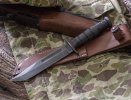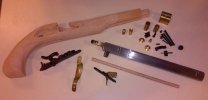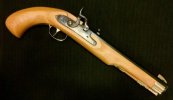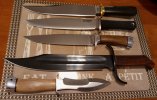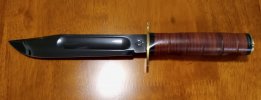Cold Bluing is not more durable than either standard hot bluing or rust bluing in fact it is not a true bluing finish at all. Cold blue creates a very thin copper like coating on the metal that wears off very easily. It's color looks like bluing but that is as far as it goes. This very thin fragile finish actually prevents rust while the foundation of real bluing is red rust which is converted into a black/bluish oxide that resists red rust (the bad stuff that eats away metal.)
Cold bluing is used as last resort for small touch ups where an entire strip and re blue is not practical. It's also included or sold side by side with gun kits and marketed as a convenient fast easy way to blue. It is not a good way to blue metal.
G
greater
, I had to quote your whole post for truth. My certified, trained, professional gunsmith buddy learned that in gun smith school. He has said those same things over and over,
especially to knife guys that think staining metal provides a wearable finish, that he just rolls with it now. 20 years of singing that song and he is done with it.
His recommended finish for carbon steels that are or have wear exposure (think knives, gun slides or parts, or whole pistols) is a phosphor finish similar to the old Parkerized finish. He sends the parts out to have that process done because it takes a license to dispose of the spent chemicals, similar to (process not the same) as metal plating. Nasty chemicals are used, extremely caustic and poisonous as they have to "cook" or corrode into the metal for its staying power and durability. IIRC correctly, he also told me the parts reside in a hot acid bath, then are cleaned, then submerged in the finishing agent to complete the phosphor (or like coating).
BTW, he isn't all the fond of Cerakote and its cousins either. Many pistols (including two of mine) have that coating and he is seeing a lot of holster wear, carry wear, and showed me a pistol that was cleaned by someone using a heavy duty chemical (MEK maybe?) that partially dissolved the finish. Certainly it's better than nothing, but his opinion is that Cerakote is little more than a great plastic finish that bonds well to metal. He would know; as he said, with all the kits/mods/parts for guns these days he does little customizing and upgrading. Almost all of his work is repair so that is his level of exposure to the gun/knife finishes.
One of my buddies bought a knife with Cerakote on the blade and it scraped right off. Check this out on the guns and Cerakote issues if you are interested:
